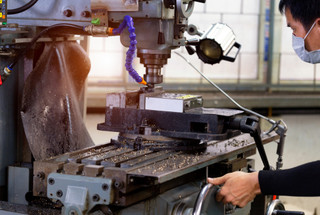Essential Maintenance Tips to Extend the Life of Your Machine Tools
Essential Maintenance Tips to Extend the Life of Your Machine Tools
Machine tools are the backbone of manufacturing—every shop relies on them to cut, shape, grind, and assemble with pinpoint accuracy.
But here's the truth: even the best machines don't last forever. What separates high-output shops from the rest isn’t just the equipment—they’re the ones who know how to keep it running longer, better, and more cost-effectively.
The trick?
Preventative maintenance. It’s not glamorous, but it's the most effective way to avoid unplanned downtime, costly repairs, or early tool replacements.
This blog will provide real-world maintenance practices, backed by tools available at Penn Tool Co., to help your machines perform like new for years.
Why Maintenance Matters More Than You Think?
Many shops run tools until they fail, then call it “wear and tear.” But in most cases, that breakdown could’ve been prevented. Proper maintenance doesn’t just prevent failure—it boosts accuracy, improves surface finish, keeps tolerances tight, and protects every part of your workflow.
Smart maintenance is proactive, a daily habit, and, with the right tools and tactics, doesn’t have to slow down your team.
Tips to Ensure Proper Cleaning of Your Tools
1. Clean Machines Are Accurate Machines
Chip buildup, coolant residue, metal dust—these aren't just messy; they're accuracy killers. Keep your machines clean every day. That means wiping down guides, clearing coolant lines, and vacuuming buildup around sensitive parts.
Tool Suggestion: DeWALT Cordless Jobsite Vacuum (DXV04T)
- Compact and portable
- Great for removing metal chips
- Keeps work zones debris-free
Even something as simple as cleaning spindle noses and tool holders reduces runout and extends life.
2. Lubrication: Your First Line of Defense
Metal-on-metal contact is brutal without lubrication. Guides, spindles, lead screws—all of it needs consistent oiling or greasing to function correctly. Don't just top off reservoirs. Know your lubrication schedule and stick to it.
Tool Suggestion: Bijur Delimon Lubrication Pumps & Systems
- Delivers accurate volume of lube
- Can be automated with timer controls
- Prevents dry runs on high-wear parts
Look for leaks, too. If a slide is dry but the tank is complete, you may have a clogged line or a faulty metering unit.
3. Calibrate Early, Calibrate Often
Machine drift is real. It happens slowly, and you won’t notice until your parts fail QA. That's why periodic calibration is a must.
Tool Suggestion: Mitutoyo Steel Gauge Block Sets
- Grade AS-1 for high-accuracy references
- Perfect for micrometers, calipers, and fixtures
- Comes with full calibration certs
Also, consider checking your DROs and linear scales against known standards. It's easy to skip this step until a client complains that their parts don’t fit.
4. Coolant Systems Need Love Too
Coolant isn't just about temperature—it also affects surface finish and tool life. Bacteria, dirt, and swarf degrade its performance quickly. Change fluids regularly and monitor concentration.
Tool Suggestion: Keller TKO-6 Portable Tramp Oil Separator
- Removes tramp oils from sumps
- Extends coolant life
- Cuts down on odors and foaming
Clean tanks, unclog nozzles, and check pH and concentration weekly. Poor coolant equals poor parts.
5. Keep the Environment Shop-Friendly
Temperature swings, humidity, and dust can damage precision equipment. Machine tools want a stable, clean environment, like a climate-controlled metrology lab.
Tool Suggestion: Starrett Granite Surface Plates
- Excellent thermal stability
- Flatness guaranteed
- Makes a perfect base for inspection
Dust control matters. HVAC systems with proper filtration protect your machines and the parts you’re measuring.
6. Spindles and Tool Holders Need Attention
The heart of your machine is the spindle. Misalignment, contamination, or improper tool changes wear it out fast. Don’t wait for it to scream.
Inspect taper surfaces, clean drawbars, and check retention force if you have a hydraulic clamping system. Replace worn-out holders—cheap ones cost more in the long run.
Tool Suggestion: Techniks CAT40 ER Collet Chuck Set
- Balanced and hardened
- Improves runout
- Better holding equals longer tool and spindle life
7. Schedule Daily, Weekly, and Monthly Checks
Set up a rotating maintenance schedule. Daily checks include fluid levels, chip trays, and visible damage. Weekly? Lube points, air filters, and belt tension. Monthly? Complete inspections of ways, gears, backlash, and axis drive components.
Use a checklist. Assign roles. Make it part of the workflow, not an afterthought.
Tool Suggestion: Maintenance Logbook or Digital App
- Log inspections, issues, and repairs
- Build a history of tool performance
- Makes troubleshooting way faster
8. Don’t Neglect Power Systems
Voltage fluctuations, damage drives, and air pressure drops affect tool changers. Make sure your shop’s power and pneumatics are stable.
Tool Suggestion: Wilkerson Air Filters and Lubricators
- Keeps air dry and clean
- Extends pneumatic life
- Includes pressure regulation and oil injection
Bad air ruins actuators and cylinder seals quickly. And dirty power? That's asking for servo faults.
9. Train People to Respect the Equipment
The best maintenance is prevention. And that starts with good habits. Don’t let anyone operate a machine unless they know:
- How to warm it up
- How to clean it
- What are the warning signs to report
Even simple things—like avoiding crashes, cleaning tool holders before changes, or reporting leaks—make a difference.
10. Partner With Pros When It Counts
When it’s time to service spindles, realign axes, or replace ball screws, bring in the experts. It costs a bit, but beats guessing and breaking something worse.
Use service techs certified by the machine manufacturer. Keep warranty records. And always insist on documented calibration after major work.
Final Word
Machine tools are built tough, but they’re not bulletproof. The right care can extend their lifespan, improve part quality, and cut unexpected costs.
With reliable gear from trusted vendors like Penn Tool Co., you get tools that perform and last when paired with smart maintenance. Make upkeep part of the process, not a panic button.
Your machines are only as good as how you treat them. So treat them like the assets they are. All the best!





